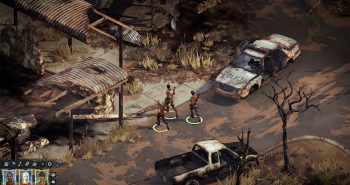Gameplay: The player can select from a few different gameplay types in Imperium Romanum. The first missions are called ‘Scenario’ missions and puts the player into the, yup – you guessed it, scenario of their choosing. These missions are open-ended, varying by what geographic location you start at, how many barbarian tribes are present and what their status towards you is. These missions are rated by difficulty and are a good way for the player to explore the different aspects of the game.
The ‘Timeline’ missions are a tree-based set of missions taking the player to different places during the age of Rome, starting with the initial settlement of Rome in 509b.c. In this gameplay mode, you select up to three different tablets (basically objectives) at a time. As you complete these objectives, you go through the tablets until they are gone. At that point, you have won the scenario and can move on to the next missions in the tree, slowly progressing forward through time.
The ‘Rome’ mode starts the player off in charge of the fledgling city of Rome and uses the tablet system to give the player objectives. In this mission you basically just grow the city of Rome into its full glory, overcoming various obstacles in the way.
City-building games have been around for a while now, so I am sure you can gather the basics: build homes, water sources, farms, stores, etc. However, unlike the Caesar games, Imperium Romanum is much more forgiving on the player. Figuring out what citizens need in a certain area is done easily by clicking on them. Every building also has an ‘effect radius’ which displays when it is clicked. This shows the player the building’s reach without external help. For instance, butcher shops need to be built within the effect radius of a pig farm in order to receive meat. However, this range can be extended by the use of slaves and warehouses that can carry the meat greater distances. Employment is a huge part of Imperium Romanum as every building needs workers, which are hired from houses within the buildings effect radius. A mine far from your town will need a house or two near it (along with a water source) in order to be staffed. This is where the advanced planning of your city comes into play.
Roads do not seem to serve a functional purpose in Imperium Romanum, save for displaying the quality of the area they are laid. They become paved when the surrounding area reaches a certain level of affluence. Aside from this and helping line up buildings, they are not used by units to travel more quickly or anything like that – strictly eye candy. Thankfully, it is free eye candy – roads cost nothing and are built instantly.
The weakest feature of the title is the combat. There are three different unit types at your command: infantry, archers, and mounted units. A fully-stocked unit consists of 36 troops and one of these groups will hail from each barracks, archery, or equestrian training building. Thats right, just one. If that building’s platoon is defeated in battle, any remaining troops must run back to their respective barracks to slowly rebuild their numbers. Commanding military units is simply a matter of clicking where you want them to go, although they do have a max-commandable range where supplies from your nearest building will not reach them and you cannot move them past this range. However, once they are in position, you can order them to attack which sends the group after the nearest barbarian camp. Combat, aside from positioning and a few basic formations, is pretty much on autopilot. It adds an additional layer to the gameplay but isn’t quite interesting enough to hold your focus for very long.
Graphics: Imperium Romanum features crisp and visually pleasing graphics. The environments are very well detailed with trees, weather effects, and water. The buildings are really where the game really shines though as structures have been modeled and textured very nicely. Citizens and units are the weakest part of the visuals as they usually have a much lower polygon count and texture resolution.
Sound / Score: The sound in Imperium Romanum is average and we have no complaints to speak of on that point. The musical score is nicely arranged, however, and adds alot to the gameplay with its sweeping melodies.
Conclusion: While combat is somewhat lackluster in Imperium Romanum, the city-building aspect of the game is fun and engaging. It should satisfy the ancient city planner in you for quite a while. In addition, Imperium Romanum features nicely done graphics while not being a strain on most computers, so it is accessible by virtually anyone thanks to that and its easy learning curve when compared to other city-builders out there.




